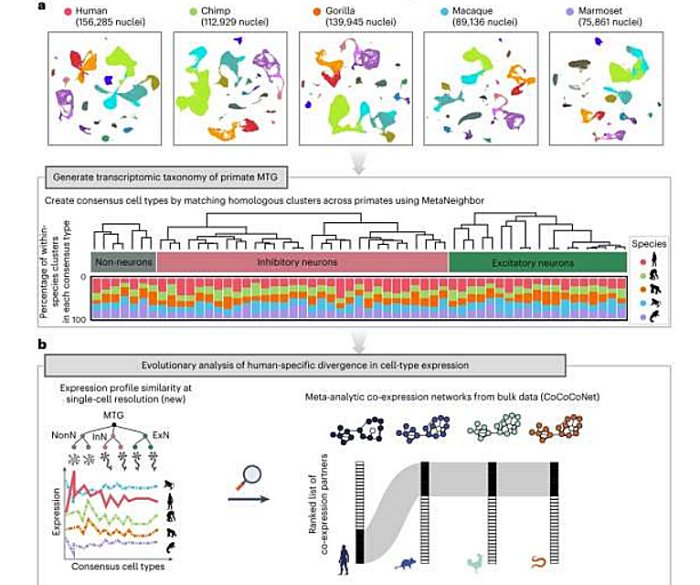Study Reveals Genes That Set Humans Apart From Other Primates In Cognitive Ability
Eddie Gonzales Jr. – MessageToEagle.com – The researchers found 139 genes common across the primate groups but highly divergent in their expression in human brains.
An international team led by researchers at the University of Toronto has uncovered over 100 genes common to primate brains but have undergone evolutionary divergence only in humans – which could be a source of our unique cognitive ability.
Schematic illustration of evolutionary analysis to infer subtle regulatory shifts underlying human-specific single-cell transcriptomic divergence. Credit: Nature Ecology & Evolution (2023). DOI: 10.1038/s41559-023-02186-7
The researchers, led by Associate Professor Jesse Gillis from the Donnelly Centre for Cellular and Biomolecular Research and the department of physiology at U of T’s Temerty Faculty of Medicine, found the genes are expressed differently in the brains of humans compared to four of our relatives – chimpanzees, gorillas, macaques and marmosets.
The findings, published in Nature Ecology & Evolution, suggest that reduced selective pressure, or tolerance to loss-of-function mutations, may have allowed the genes to take on higher-level cognitive capacity. The study is part of the Human Cell Atlas, a global initiative to map all human cells to better understand health and disease.
“This research contributes to our understanding of differences in the brain between humans and other primates at the cellular level, but it has also resulted in a database that can be used to further characterize genetic similarities and differences across primates,” said Gillis.
The team, which includes researchers from Cold Spring Harbour Laboratory and the Allen Institute for Brain Science in the U.S, created a brain map for each primate species based on single-cell analysis, a relatively new technique that enables more specific genetic sequencing than standard methods. They used a BRAIN Initiative Cell Census Network (BICCN) dataset created from samples taken from the middle temporal gyrus of the brain.
In all, the team found 139 genes that are common across the primate groups but highly divergent in their expression in human brains. These genes displayed a stronger ability to withstand mutations without impacting their function, suggesting they may have evolved under more relaxed selective pressure.
“The genes that have diverged in humans must be tolerant to change,” said Hamsini Suresh, first author on the study and a research associate at the Donnelly Centre. “This manifests as tolerance to loss-of-function mutations, and seems to allow for rapid evolutionary change in the human brain.”
Our higher cognitive function may have resulted from the adaptive evolution of human brain cells to a multitude of less threatening mutations over time. It’s also worth noting that around a quarter of the human-divergent genes identified in the study are associated with various brain disorders.
The divergent genes the researchers identified are found in 57 brain cell types, grouped by inhibitory neurons, excitatory neurons and non-neurons. A quarter of the genes were only expressed differently in neuronal cells, also known as grey matter, and half were only expressed differently in glial cells, which are white matter.
Grey matter in the brain consists of neurons, while white matter consists of other cell types, including those responsible for vasculature and immune function.
This study is part of the BICCN initiative to identify and catalogue the diverse cell types in the brains of humans and other species. In 2021, the consortium published a comprehensive census of cell types in the mouse, monkey and human primary motor cortex in the journal Nature. The initiative is shedding light on the evolution of the brain by studying neurotransmission and communication at the finest resolution.
“There are around 570,000 cells in the cross-primate single cell atlas of the middle temporal gyrus,” said Suresh. “Defining a catalogue of shared cell types in this area of the brain provides a framework for exploring the conservation and divergence of cellular architecture across primate evolution. We can use the resulting information to study evolution and disease in a more targeted manner.”
Original story – University of Toronto
Written by Eddie Gonzales Jr. – MessageToEagle.com Staff Writer











